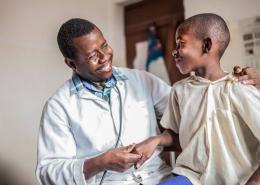How Next-Generation Sequencing Is Helping to Build Better Vaccines

If you’ve ever tried an at-home genetic testing kit, you’re familiar with whole-genome sequencing, the technology that allows people to quickly and easily map their DNA. This same technology is now being used to track the genomes of potentially deadly microbes.
During global disease outbreaks, scientists have long used genotyping tools to understand pathogens and track genetic changes. But in recent years, as the sequencing technology has become faster and more affordable, researchers are harnessing these tools to generate population-level data on pathogen genomes that may be used to help develop more effective vaccines.
“Traditional sequencing methods first developed in the 1970s were very labor-intensive and took up to three years,” says Li Hao, Senior Principal Scientist of Vaccine Research and Development at Pfizer’s Pearl River, New York, research site. “With next-generation sequencing (NGS), we can generate the genomes of hundreds of bacteria within weeks, and by combining that with advanced bioinformatics approaches, we can identify genetic patterns related to a pathogen.”
Here are two examples of how genome sequencing is providing valuable data to help develop better vaccines:
Vaccine design
When selecting the antigens to include in a vaccine, scientists monitor the most prevalent strains of a disease circulating the globe in hopes of developing a vaccine formulation covering those strains. “You can’t just look at laboratory strains that may have been isolated 50 years ago; you need to genotype the pathogens isolated from individuals with confirmed cases of the infection, and this needs to be done on a global scale,” says Paul Liberator, Senior Director of Vaccine Research and Early Development, also based in Pearl River.
In their recent work to develop a meningococcal group B vaccine, Pfizer scientists worked with various reference labs around the globe to obtain sequencing data and track the bacterial strains. Using whole-genome sequencing data helps ensure the vaccine has the most up-to-date coverage.
Studying “carriage” microbes
Many people unknowingly carry infectious disease-causing pathogens in their noses, mouths, and throats without getting sick. In some cases, these pathogens can be transmitted to another person and cause disease.
For example, some 30 to 50 percent of children under the age of 5 carry the bacteria Streptococcus pneumoniae in their noses but don’t get sick. These asymptomatic “carriage” bacteria have important implications for understanding how diseases work and population-level impact.
Empowered by NGS, scientists are studying the genetic diversity of these carriage bacteria to try to better understand the effectiveness of the pneumococcal conjugate vaccine (PCV) against infections. “NGS provides us an unprecedented resolution to examine colonization and transmission of these asymptomatic carriage isolates,” says Li. “It can also give us a heads-up to emerging lineages of disease strains and help develop a broad-spectrum pneumococcal vaccine candidate.”
Scientists expect NGS to be a transformative tool to help scientists develop vaccines that have a more-effective global reach. “The application of NGS early in the process should help us identify the bacteria that are circulating globally and help ensure we are developing a vaccine that can be used for the whole world and not just in a specific region,” says Annaliesa Anderson, Vice President and Chief Scientific Officer of Bacterial Vaccines at Pfizer.





